![[Lancashire and Yorkshire Railway flag]](../images/g/gb$lyrw.gif) image by António Martins-Tuválkin, 18 February 2007
image by António Martins-Tuválkin, 18 February 2007
Last modified: 2012-06-20 by rob raeside
Keywords: railway |
Links: FOTW homepage |
search |
disclaimer and copyright |
write us |
mirrors
See also:
In the 1930s the flag was white with a red border top and bottom and part of
the arms of the GWR in the centre; the shield and crest of the cities of Bristol
and London within a garter bearing the name of the company.
David
Prothero, 14 March 2008
![[Lancashire and Yorkshire Railway flag]](../images/g/gb$lyrw.gif) image by António Martins-Tuválkin, 18 February 2007
image by António Martins-Tuválkin, 18 February 2007
Post card collection shows a blue and red
quartered flag with a large white Maltese cross over all and white serif capital
letters "L" on the hoist side blue area and "Y" on the fly side blue area.
António Martins-Tuválkin, 18 February 2007
![[Lancashire and Yorkshire & North Eastern Railways flag]](../images/g/gb~lyne.gif) image by António Martins-Tuválkin, 4 July 2007
image by António Martins-Tuválkin, 4 July 2007
Post card collection shows “LYR/NER Joint
Service, Hull”. A variant of the Lancashire & Yorkshire Railway
flag, we see the same blue and red quartered flag without the central emblem,
however, and bearing white initials LY (upper quarters) and NE (lower quarters).
See also the on-line 1912 Lloyds Flags & Funnels:
http://www.mysticseaport.org/library/initiative/Impage.cfm?PageNum=74&bibid=11061&ChapterId=8,
no. 1520 bearing the LYNE initials (‘Lancashire and Yorkshire & North Eastern
Railways / Hull & Zeebrugge Service') and no. 1521 bearing the cross and the LY
initials ('Lancashire and Yorkshire Railway / Goole and Continental Service').
The NER mentioned above was the North Eastern Railway absorbed by the London &
North Western Railway (1923) which had acquired Lancashire and Yorkshire Railway
the year before. All this and much more on this Ships List page, first of a set
of four:
http://www.theshipslist.com/ships/lines/feeders.html
L&YR enthusiasts site:
http://www.lyrs.org.uk/
Simplon PC pages which will come in handy:
http://www.simplonpc.co.uk/LMS_LYR1.html
http://www.simplonpc.co.uk/LMS_LYR2.html
Jan Mertens, 20 February 2007
![[variant flag]](../images/g/gb~lyner.gif) image by
Klaus-Michael Schneider,
14 May 2012
image by
Klaus-Michael Schneider,
14 May 2012
The variant flag is quarterly divided into blue (upper hoist/lower fly) and red (lower hoist/upper fly). In the quarters are white initials “L” (upper hoist), “y” (upper fly, lower case(!!)), “N” (lower hoist) and “E” (lower fly).
Source: Lloyds F&F 1912; p.109, image 1520
Klaus-Michael Schneider, 14 May 2012
![[Lancashire and Yorkshire & London and Northwestern Railways flag]](../images/g/gb$lylnw.gif) image by António Martins-Tuválkin, 1 August 2007
image by António Martins-Tuválkin, 1 August 2007
Post card collection shows a red flag
with a white cross throughout charged with a green shamrock on its center and
with white lettering in all four red quarters (clockwise from the top hoist):
"L&Y", "L&NW", "RLY" and "COYS"
António Martins-Tuválkin, 21 February 2007
The shamrock seems to refer to an Irish connection. This company did run
services from London to Holyhead, part of the main route by train and sea to
Dublin, and carried Irish mail on this route, but I wouldn't have expected this
to be emphasised in the flag. The Lancashre and Yorkshire entered into a working
relationship with the London & North Western Railway in 1922, but they then
grouped into the London, Midland and Scottish Railway in 1923.
Jonathan Dixon, 21 February 2007
![[London and Northwestern Railway flag]](../images/g/gb$lnwr.gif) image by António Martins-Tuválkin, 19 February 2007
image by António Martins-Tuválkin, 19 February 2007
Post card collection shows a red burgee
with a white cross throughout and over all a very large white disc edged black
containing a representation of Britannia.
António Martins-Tuválkin, 19 February 2007
![[London and Southwestern Railway flag]](../images/g/gb$lswr.gif) image by António Martins-Tuválkin, 9 January 2008
image by António Martins-Tuválkin, 9 January 2008
Post card collection shows a blue flag with
large cartouche filled with the following arms: Per pale, the I London, and the
second per fess Argent and Gules three roses two and one counterchanged.
António Martins-Tuválkin, 19 February 2007
An image of the flag is present in 1912 Lloyds Flags & Funnels, no. 1203: http://www.mysticseaport.org. See also here (bearing in mind that this is a modern re-creation for commercial purposes). The shield is less simple, it may be a later version. The roses at any rate represent the company seat, Southampton.
Some history can be found at
http://www.soc.staffs.ac.uk/~cmtdtr/collect/lsw_enam.html,
http://www.simplonpc.co.uk/SR_LSWR1.html and for Southampton at
http://www.ngw.nl/int/gbr/s/southamp.htm.
Jan Mertens, 23 February 2007
A light blue flag with a large emblem on it, showing a coat of arms shield
encircled by a garter. I used slightly different renditions of this taken from
http://www.moonroller.com/jebbitt/graphics/lswr.gif and
http://www.moonroller.com/jebbitt/graphics/lsw_enam.gif.
António Martins-Tuválkin,
9 January 2008
![[London & South Western and London, Brighton & Southern Coast
Railway]](../images/g/gb$lsww.gif) image by António Martins-Tuválkin, 9 January 2008
image by António Martins-Tuválkin, 9 January 2008
Post card collection shows a horizontally divided flag with the flag of the London and Southwestern
Railway (q.v.) on top and a blue saltire on white, charged with a red cross
coupe, on the bottom. Can we assume that the latter pattern is the flag of the
London, Brighton & Southern Coast Railway?
António Martins-Tuválkin,
9 January 2008
![[London, Brighton & South Coast railway flag]](../images/g/gb$lbscr.gif) image located by
António Martins-Tuválkin, 19 February 2007
image located by
António Martins-Tuválkin, 19 February 2007
A website showing
objects recovered from shipwrecks
http://www.users.globalnet.co.uk/~indigo/flags.htm (fourth picture) shows
the house flag of the London, Brighton & South Coast Railway. It can be
described as a St George cross – red on white, throughout – with the upper left
quarter diagonally divided blue above white ((ascending diagonal), the upper
right one diagonally divided red above white (descending diagonal), the lower
left one white above red (descending diagonal) and the lower right one white
above blue (ascending diagonal). The company name gives precedence to the
British side but it also has French connections. The
initials L.B. & S.C. are shown on the garter surrounding the flag but also the
word ‘Ouest’ (French for ‘West’) and an additional scroll bears the words
‘Newhaven & Dieppe Service’.
Here is a link to
Dominique Cureau's site on French house flags, where the flag is basically
the same – the cross is somewhat thicker – identified as that of the French
State railway (source given as Talbot-Booth). The
on-line 1912 Lloyds Flags & Funnels has this flag as well under No. 1800.
under ‘London Brighton & South Coast and French State Railways Newhaven-Dieppe
Service’.
The British company existed – in this form – from 1846 to 1923, as documented at
http://www.lbscr.demon.co.uk/index.html. More information about the French
connection (1867 text) can be found at
http://steve.pickthall.users.btopenworld.com/ssx1867/newhaven1867.html:
“Newhaven has become a considerable port for continental traffic; a branch of
the London, Brighton, and South Coast Railway connects it with London, and fast
steamers ply daily to and from Dieppe, in connection with the Western Railway of
France (Chemins de Fer de l’Ouest, jm), forming the most direct line from London
to Paris: this route is preferred by many, not only for its regularity and
cheapness, but also for the beauty of the scenery from Dieppe to Paris.”
The following page shows a series of French posters for this service:
http://perso.wanadoo.fr/roland.arzul/etat/affiches/affiches5.htm, and
another page (in French) gives the date of foundation of the common service as
1859, shows the house flag, etc.:
http://perso.wanadoo.fr/roland.arzul/etat/inattendu/dieppe.htm. The Chemins
de Fer de l’Ouest became French state property in 1908.
Jan Mertens, 23 November 2005
This post card collection confirms the
flag.
António Martins-Tuválkin, 19 February 2007
![[London, Chatham & Dover Railway]](../images/g/gb$lcdr.gif) image by António Martins-Tuválkin, 9 January 2008
image by António Martins-Tuválkin, 9 January 2008
Post card collection shows an ascending
diagonally divided flag of blue over red with lettering "LC&DR" in bold white
sans serif capitals, slightly offset to the top.
António Martins-Tuválkin,
9 January 2008
![[London, Chatham & Dover Railway]](../images/g/gb~lcdrr.gif) image by Eugene Ipavec, 24 July 2010
image by Eugene Ipavec, 24 July 2010
Griffin 1891 (a later edition that Griffin 1883)
gives a variant version with slender
initials (no serifs), three dots only, and without ampersand. A more important
difference however is the descending diagonal line defining a blue hoist and a
red fly which is no. 324 on p. 16 of that source. Caption: ‘Lon. Chatham &
Dover Ry, London’.
I really do not know which version is the
right one (that is, supposing the house flag was never modified). In any case
the company started out as the East Kent Railway (1858) and adapted its new name
one year later. As we know, it merged with South Eastern Railway in 1899. More
information here:
http://en.wikipedia.org/wiki/London,_Chatham_and_Dover_Railway.
Jan
Mertens, 19 August 2009
![[London, Midland and Scottish Railway flag]](../images/g/gb$lmsr.gif) image by António Martins-Tuválkin, 19 February 2007
image by António Martins-Tuválkin, 19 February 2007
Post card collection shows a red flag with
a white cross throughout and over all a very large white disc edged black
containing the company emblem, which is a heraldic crest (wing on a torse
charged with what seems to be a cross per gyronny) surrounded at the bottom and
sides by branches of thistle (fly) and rose (hoist), which are canting elements.
António Martins-Tuválkin, 19 February 2007
The wing is a dragon's, it bears a red cross and refers to the crest of the City of London (where the wing is silver however): http://www.railwayfriends.org/plaqueslarge/rc18.html.
The above given for detail, this one seems nearer the mark:
http://www.kesr.org.uk/acatalog/London_Midland_Scottish_Railway_badge.jpg
Jan Mertens, 22 February 2007
![[Midland Railway flag]](../images/g/gb$mlrw.gif) image by António Martins-Tuválkin, 19 February 2007
image by António Martins-Tuválkin, 19 February 2007
Post card collection shows a white
swallowtail flag with the crest of the company coat of arms on it (http://www.midlandrailwaystudycentre.org.uk/MirrorCrest.gif).
This is a green wyvern with red and white striped belly and red spinal horns and
wings.
António Martins-Tuválkin, 10 January 2008
![[London and North Eastern Railway flag]](../images/g/gb$lner.gif) image by António Martins-Tuválkin, 21 February 2007
image by António Martins-Tuválkin, 21 February 2007
Post card collection shows a blue flag
with a white saltire charged over all with a white red-edged lenticular
shape charged with red sans-serif capitals spelling "LNER", the two middle
letters being larger.
António Martins-Tuválkin, 21 February 2007
The saltire would seem to be a reference to the fact that the LNER operated
the East Coast Main Line link between London and Edinburgh, including the famous
Flying Scotsman service. The LNER was formed in 1923 as a result of the 1921
Railways Act grouping the railways. It served the east of Scotland and England
north of London, and existed until nationalisation in 1948.
Jonathan Dixon, 21 February 2007
1923-33 flags were also in this pattern but the LNER logo is shown in the
post card collection in a pillbox shape (the
outline of two discs connected by parallel tangents). Additionally these three
flags had a specific symbol on the hoist side triangle area of the background.
None of these is shown on the LNER coat of arms:
http://www.crphillips-models.co.uk
![[London and North Eastern Railway flag]](../images/g/gb$lnerc.gif) image by António Martins-Tuválkin, 8 August 2007
image by António Martins-Tuválkin, 8 August 2007
London & North Eastern Rly. (1923-33 for former Gr. Central Rly.
Ships). As described, with white red fimbriated upright five-pointed star.
António Martins-Tuválkin, 8 August 2007
![[London and North Eastern Railway flag]](../images/g/gb$lnere.gif) image by António Martins-Tuválkin, 8 August 2007
image by António Martins-Tuválkin, 8 August 2007
London & North Eastern Rly. (1923-33 for former Gr. Eastern Rly.
Ships). As described, with red wing crest on torse. This seems to be the
London city crest, but the wing is depicted as plain red, not patterned
after a St. George Cross.
António Martins-Tuválkin, 8 August 2007
![[London and North Eastern Railway flag]](../images/g/gb$lnern.gif) image by António Martins-Tuválkin, 9 August 2007
image by António Martins-Tuválkin, 9 August 2007
London & North Eastern Rly. (1923-33 for former North British Rly. Steamers. As described, with white ogival shield charged with a thistle
proper (the image is too small to be sure, though).
António Martins-Tuválkin, 9 August 2007
The common house flag with an identifying emblem in the hoist was introduced
17 February 1932 as an economy measure. The original house flags, introduced 24
April 1923 were:
Harwich. St Andrew's flag with a red dragon's left wing on
a central white circle.
Grimsby. A white star on a red pennant.
Scottish
Services. Thistle on a white shield on a red pennant.
[National Archives
(PRO) RAIL 390/305]
David Prothero, 7 January 2009
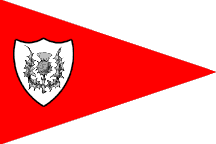 image by António Martins-Tuválkin,
6 May 2010
image by António Martins-Tuválkin,
6 May 2010
From a postcard collection: 10.3.1: North
British Railway
Postcard #10, 3rd row, 1st flag of the
collection reads "North British Railway" and
shows a red pennant with a black thistle on a white, black edged, ogival shield.
António Martins-Tuválkin,
6 May 2010
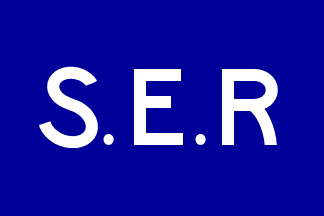 image by Eugene Ipavec, 18 August 2009
image by Eugene Ipavec, 18 August 2009
A British railway firm operating ships was the South Eastern Railway Co.
founded in 1844. As described by The Ships
List:
“In 1854 the South Eastern Railway Company took over the fleet
of the South Eastern & Continental SP Company and ran Folkestone /
Dover-Boulogne / Ostend services. In 1899 the company merged its fleet with the
London, Chatham & Dover Railway to form the South Eastern & Chatham Railway
Company joint fleet. (...) They ran services between Folkestone / Dover -
Calais / Boulogne. In 1923 they became part of Southern Railway.”
Griffin’s ‘Flags National and Mercantile’ (1891), from the third edition of
Griffin (1885), shows the house flag under no.
515: ‘S. Eastern Railway Co. London’. It is a dark blue field, white
initials “S.E.R” (two dots only; no serifs). The ‘Scran’ site shows a modern
rendition with three dots:
http://www.scran.ac.uk/database/record.php?usi=000-000-550-930-C. Additional
information:
http://en.wikipedia.org/wiki/South_Eastern_Railway_(UK) and
http://www.simplonpc.co.uk/SR_SECR1.html.
Jan Mertens, 17 August 2009
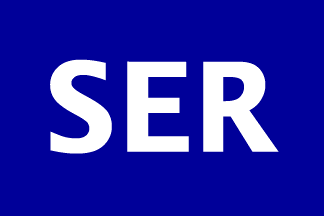 image by António Martins-Tuválkin, 10 May 2010
image by António Martins-Tuválkin, 10 May 2010
Variant flag shown on a postcard collection: 11.2.14 South
Eastern Railway.
Postcard #11, 2nd row, 4th flag of the
collection reads "South Eastern Railway",
early funnels black, and shows a dark blue flag with "SER" centered on it, set
in white bold san-serif capitals [without periods].
António Martins-Tuválkin, 10 May 2010
 image by Neale Rosanoski, 4 December 2010
image by Neale Rosanoski, 4 December 2010
According to
Lloyds (1912) and the Liverpool Chamber of Commerce 1885 sheet the
letters, without dots, were in the base of the flag and above them was a
vertical white anchor. The version without the
anchor is shown by
Griffin (1883) [no edition number given] which shows dots after
each letter in line with the Scran site and also it is so described in Merchant
Fleets No. 24 where the author states that the flag was "blue with the white
letters S.E.R." although it is then displayed on the on the back cover without
dots in line with the image by António.
Neale Rosanoski, 4 December
2010
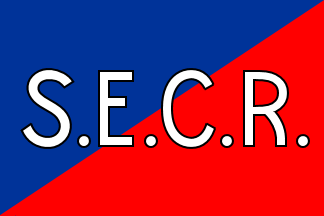 image by Eugene Ipavec, 19 August 2009
image by Eugene Ipavec, 19 August 2009
The on-line 1912 Lloyds Flags & Funnels shows
the house flag as no. 1793 on original page 122:
http://library.mysticseaport.org/initiative/ImPage.cfm?PageNum=87&BibId=11061&ChapterId=8
- Divided per ascending diagonal, blue (hoist) and red (fly), white company
initials “S.E.C.R.” over all; these letters are rather thin and have no serifs.
The complete caption found in this
1912 source: ‘South Eastern & Chatham Railway, Royal Mail Service,
London’.
Jan Mertens, 18 August 2009
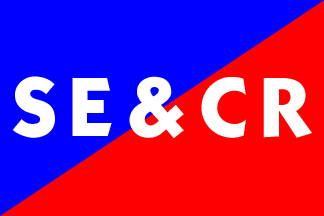 image by António Martins-Tuválkin, 13 May 2010
image by António Martins-Tuválkin, 13 May 2010
Variant flag shown on a postcard collection:
12.1.1 South
Eastern and Chatham Railway.
Postcard #11, 1st row, 1st flag of the
collection reads "South Eastern and
Chatham Railway", and shows a ~2:3 diagonally divided flag, blue on the upper
hoist and red on the lower fly reading "SE&CR" in one centered line overall set
in white bold sans serif capitals. See
http://en.wikipedia.org/wiki/South_Eastern_and_Chatham_Railway &
http://en.wikipedia.org/wiki/South_Eastern_and_Chatham_Railway#Ships about
the company and its ships (I have no idea if the flag was used also ashore).
António Martins-Tuválkin,
13 May 2010
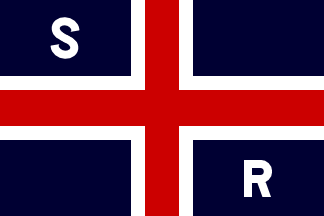 image
by Eugene Ipavec, 17 August 2009
image
by Eugene Ipavec, 17 August 2009
From
http://www.plimsoll.org/OnTheLine/ShippingLines/southernrailwaycompany/default.asp#2:
The London & South Western Railway, active since 1840, starts shipping in 1843
as the 'New South Western Steam Navigation Company'. Other railway firms start
cross-Channel and coastal shipping lines; various mergers occur. Finally, in
1923, "the London & South Western, London Brighton & South Coast and South
Eastern & Chatham Railway Companies merge to form the Southern Railway. The new
company operates trains and ships across the south east of England". When after
WWII the British Transport Commission assumes control of the railways, the
shipping activities follow (1948). The situation does not change on the
formation of British Rail, however its shipping activities come to an end when
Stena and Sealink UK acquire them (1979).
The Southern Railway house flag was blue with a red cross throughout, fimbriated
white, and white letters 'S' (upper hoist) and 'R' (lower fly).
Jan Mertens, 15 April 2005
An image of a Southern Railway flag is seen at
http://www.bluebell-railway-museum.co.uk/images/a007.JPG.
Jan Mertens,
16 August 2009
A postcard collection: 12.1.2 Southern Railway.
Postcard #11,
1st row, 2nd flag of the
collection reads "Southern Railway", and shows
essentially the same flag as above, but in the brighter shades of both red and
dark blue of this source; the red cross is thicker and its white fimbriation
thinner, as well as the letters.
António Martins-Tuválkin, 13 May 2010